Background history of Korea’s National Police Agency in English
1970 SERIES
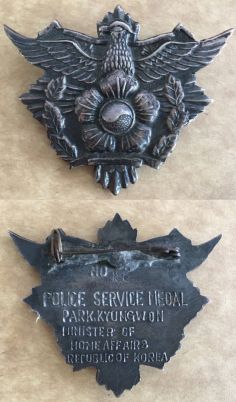
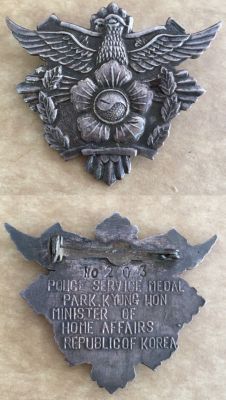
On May 27, 1970, the 내무부령 Ministry of Home Affairs issued 경찰표창규정시행규칙 제80호 Police Commendation Enforcement Rule #80. This legislation actually authorized two different medals. There is a Police Merit Medal and a Police Cooperation Medal. The front is the same on both medals, with the use of the Korean National Police Badge. The inscription on the reverse is different.
The Police Merit Medal reverse inscription reads in four lines: 제….호 “Serial Number”, 경찰공로장 “Police Merit Medal”, 내무부장관 “Minister of Home Affairs”, and 치안국장 “Police Director”. I have not been able to find pictures of an actual medal.
The Police Cooperation Medal reverse inscription reads in three lines: 제….호 “Serial Number”, 경찰협력장 “Police Cooperation Medal”, and 내무부장관 “Minister of Home Affairs”. In the drawing within the legislation, there is actually a fourth line which reads (치안국장) “Police Director”. I have not been able to acquire pictures of this medal, so it is possible that the line 내무부장관 “Minister of Home Affairs” might be replaced with 치안국장 “Police Director”. More research is needed.
Pictured here are two examples of the Korean Police Service Medal. There is nothing in the original legislation which authorized these reverse inscriptions. Since the reverse is in English, I suspect that these Police Service Medals were given to high-ranking dignitaries who visited the National Police Headquarters.
1982 SERIES
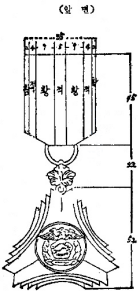
On Sept. 29, 1982, the 내부부장 “Ministry of Home Affairs” issued new 경찰표창규정시행규칙 제382호 “Police Commendation Enforcement Rules #382”. Within this legislation, they created two newly designed Medals: a Merit Medal and a Cooperation Medal. For the Merit Medal, there are two basic types, one for Achievement and one for Honors and Encouragement.
The award criteria is perplexing, and the only way to give some clarity is to look at the Award Document Criteria. The legislation states: “When the commendation is awarded, a certificate of appreciation in Attached Form No. 2 for achievement awards, a certificate of appreciation in Attached Form No. 3 for honors and encouragement awards, and a certificate of appreciation in Attached Form No. 4 for cooperation awards.” The legislation further states that for Cooperation Awards, the award document can be in a foreign language, but must be in Korean for all other awards.
I have not been able to acquire adequate pictures of the two medals and must rely on the drawings in the original legislation. The obverse drawings for both medals are identical, only the reverse drawings are different. The planchet is noted as being 52 mm high (in later examples of this medal, the width is 57 mm). The ribbon is 45 mm x35 mm with a stripe pattern of yellow 2 mm, red 4 mm, yellow 9 mm, red 5 mm, yellow 9 mm, red 4 mm, yellow 2 mm. The ribbon bar is 35 mm x 10 mm and the lapel pin is 12 mm x 10 mm. The stripe pattern for both the ribbon bar and the lapel pin are the same as the medal drape, but unlike the drape, they have a small police emblem in the center.
For the achievement award, the reverse inscription is: on the top line 대한민국경찰 “Republic of Korea Police”, and on the second line 공로장 “Merit Medal”. The third line can either be one of two different inscriptions: 내부부장관 “Minister of Home Affairs” or 내부부장치안본루장 “Ministry of Home Affairs Public Security Center”. For the Cooperation Medal, the reverse inscription is the same, except for the second line which reads 협력장 “Cooperation Medal”.
1991 SERIES
On Sept. 19, 1991, the Ministry of Home Affairs issued 경찰표창규정시행규칙 제543호 “Police Commendation Enforcement Rules #543”. I cannot find a copy of this legislation with the drawings. Details concerning the medal, it’s design, reverse inscriptions, ribbon colors etc. are contained in the drawings, not in the general text. The only thing that I can discern is that the Merit Medal is now in three classes, with gold plating on the 1st Class, silver plating on the 2nd Class and copper plating on the 3rd Class. The Cooperation Medal is still in a single class.
1997 SERIES
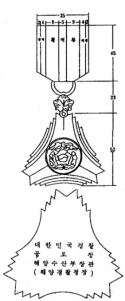
On Jan. 28, 1997 the 해양수산부 “Ministry of Oceans and Fisheries” issued a new 경찰표창규정시행규칙 제543호 “Police Commendation Enforcement Rule #8”. The Merit Medal is still in three classes, with gold plating on the 1st Class, silver plating on the 2nd Class and copper plating on the 3rd Class. The Cooperation Medal is no longer a single class, but, like the Merit Medal, it is divided into 3 Classes, with the same plating pattern as the Merit Medal.
I have not been able to acquire adequate pictures of the two medals and must rely on the drawings in the original legislation. The obverse drawings for both medals are identical, only the reverse drawings are different. The planchet is noted as being 52 mm high (in later examples of this medal, the width is 57 mm). The ribbon is 45 mm x35 mm with a stripe pattern of yellow 2 mm, red 4 mm, yellow 9 mm, red 5 mm, yellow 9 mm, red 4 mm, yellow 2 mm. The ribbon bar is 35 mm x 10 mm and the lapel pin is 12 mm x 10 mm. The stripe pattern for both the ribbon bar and the lapel pin are the same as the medal drape, but unlike the drape, they have a small police emblem in the center.
For the achievement awards, the reverse inscription is: on the top line 대한민국경찰 “Republic of Korea Police”, and on the second line 공로장 “Merit Medal”. The third line can be either one of two different inscriptions: 해양수산부장관 “Minister of Oceans and Fisheries” or 해양경찰청장 “Commissioner of the Maritime Police Agency”. For the Cooperation Medal, the reverse inscription is exactly the same, except for the second line which reads 협력장 “Cooperation Medal”. There is nothing on the reverse inscription to indicate the class.
2007 SERIES
On Oct. 30, 2007, the 경찰청훈령 “National Police Agency” issued 경찰표창규칙 제514호 “Police Commendation Rule #514”.
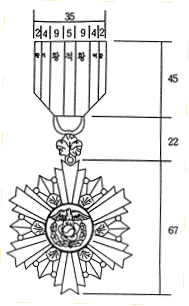
There are now three separate types of awards: 1) 공적상 “Achievement”, 2) 우등상 “Honor” and 3) 협조상 Cooperation. There is information with the drawing showing that the medal comes in two classes, with the 1st Class being gold-plated brass and the 2nd Class being silver plated brass. The legislation goes into a great deal of discussion on who can receive each type of award, but does not discuss the criteria for each class.
The Achievement Award is awarded to police agencies, police officers, combat police officers, and other civil servants at all levels who have made a clear achievement in the development of police affairs by faithfully performing their duties or providing dedicated service.
The Honors Awards are 1.) awarded to individuals and organizations who are exemplary of others because of their decent behavior and particularly excellent academic performance among the education conducted by the police educational institution, or to individuals and organizations who have achieved excellent grades in various competitions organized or sponsored by the police institution and 2.) an incentive award may be awarded to a person who meets the subject of awarding an Honor Prize pursuant to paragraph (1).
The Cooperation Award is awarded to individuals (including foreigners and organizations) who have made a clear achievement by actively cooperating in the performance of police duties.
In the legislation, there is only one drawing of the reverse, with has three lines of text. Across the top is 대한민국경찰 “Republic of Korea Police”, and on the second line 공로장 “Merit Medal”, and 경찰청장 “Police Commissioner” on the third line.
I have not been able to acquire adequate pictures of the medal and must rely on the drawings in the original legislation. The planchet is noted as being a little larger than the previous design at 67 mm high. The ribbon is still 45 mm x35 mm with a stripe pattern of yellow 2 mm, red 4 mm, yellow 9 mm, red 5 mm, yellow 9 mm, red 4 mm, yellow 2 mm. The ribbon bar is 35 mm x 10 mm and the lapel pin is 12 mm x 10 mm. The stripe pattern for both the ribbon bar and the lapel pin are the same as the medal drape, but unlike the drape, they have a small police emblem in the center.
2009 SERIES
On July 31, 2009, the 경찰청훈령 “National Police Agency” issued 경찰표창규칙 제545호 “Police Commendation Rule #545”.
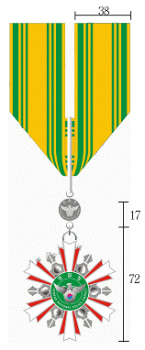

Police Commendation Rule #545 is almost identical to the previous 2007 Series. The only difference lies in the physical form of the medals. The pendants are identical but at 72 mm, they are a little larger. The Mugunghwa flower in the suspension has been replaced with the National Police Emblem. The 45 × 35 breast ribbon has been replaced with a cravat. The drawing shows the ribbon has a width of 38 mm, but does not give the length measurement.
There is no indication of the stripe dimensions, but later examples of these medals have, what, I believe, are the same measurements, approx. 2 mm yellow, 4 mm green, 1.5 mm yellow, 1.5 mm green, 1.5 mm yellow, 1.5 mm green, 13 mm yellow, 1.5 mm green, 1.5 mm yellow, 1.5 mm green, 1.5 mm yellow, 4 mm green, and 2 mm yellow.
The legislation does include drawings of the reverse, but the quality is so low that it is almost impossible to discern. Nevertheless, there are definitely 4 flat lines of text. I believe the top line has 대한민국경찰 “Republic of Korea Police”, the second line can be issued as either 1 등급 공로장 “1st Class Merit Medal” or 2 등급 공로장 “2nd Class Merit Medal”. The third line can be issued as either 금장 “Gold Medal” or 은장 “Silver Medal”. The fourth line appears to be 경찰청장 “Police Commissioner”.
The ribbon bar is 38 mm x 10 mm and the lapel pin is 12 mm x 10 mm. The stripe pattern for the ribbon bar is the same as the cravat. The lapel pin is yellow with two vertical green stripes (no dimensions available). Both the ribbon bar and the lapel pin have a small police emblem in the center. The police emblem appears to be a gold color for the 1st Class and a silver color for the 2nd Class.
To be continued…….
